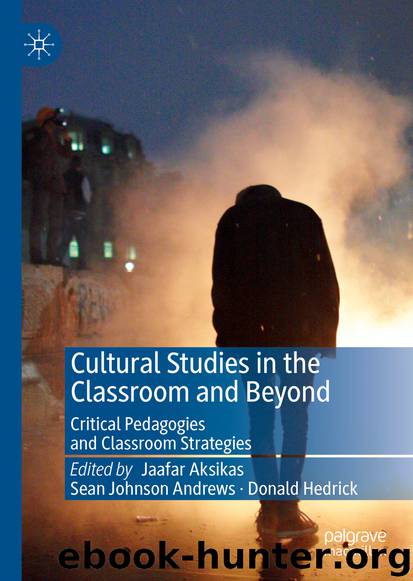Cultural Studies in the Classroom and Beyond by Jaafar Aksikas & Sean Johnson Andrews & Donald Hedrick

Author:Jaafar Aksikas & Sean Johnson Andrews & Donald Hedrick
Language: eng
Format: epub
ISBN: 9783030253936
Publisher: Springer International Publishing
One piece of the work of the US institutionalization of the field occurred first just 150 miles from us—at the University of Illinois at Urbana-Champaign, where Lawrence Grossberg, Cary Nelson, and Paula Treichler helped organize the landmark conference that resulted in their 1992 anthology on Cultural Studies. But where their institutional situation led them to declare cultural studies as “actively and aggressively anti-disciplinary,” ours at Columbia College Chicago did not allow for such a position: instead it demanded we project a disciplinary coherence to cultural studies that some of its early adherents continue to disavow. Not only did we face local institutional factors—the kind that sit next to you in the departmental faculty meeting—but more importantly, our major served only undergraduate students: in order to provide them with a clear set of parameters, processes, rubrics, courses, and (ultimately) grades, we had to be clear about what cultural studies was, what it meant, and how you could go about teaching a diverse group of students how to do cultural studies.
Doing cultural studies has long been the topic of textbooks—most notably the collection by Hall and DeGuy analyzing the Sony Walkman (2013), which takes that topic as its title. But practical guides in conducting or using cultural studies have proliferated well beyond those early Open University publications (Barker 2011; Johnson et al. 2004; McRobbie 2005; Ryan 2010; Sardar 2010; Saukko 2003). With so many recent texts written, published, and evidently sold to students and teachers in the field, it is evident that the contours of the field are more defined than the “anti-disciplinary” reputation would suggest.
In surveying these, the methodology of cultural studies that emerges is close to what Johnson recommends in his 1987 essay, “What Is Cultural Studies Anyway?” Though Johnson argues that, “Cultural studies must be inter-disciplinary (and sometimes anti-disciplinary) in its tendency” (Johnson 1986, p. 43), he ultimately outlines a methodology that is common to the field, if not a specifically disciplinary one. First, it is a radically contextualist methodology, meaning it begins from a coherent and rigorous understanding of the way its objects of study fit into a specific, historical, geographic, political economic, social, and ideological context. To do this, practitioners must marshall a revised version of the methods of disciplines that have an accepted, valid claim to producing partial knowledge about this context: history, geography, sociology, and so on. Here, we can draw from Hall’s description of cultural studies and its intervention in the crisis in the humanities:Serious interdisciplinary work involves the intellectual risk of saying to professional sociologists that what they say sociology is, is not what it is. We had to teach what we thought a kind of sociology that would be of service to people studying culture would be, something we could not get from self-designated sociologists. It was never a question of which disciplines would contribute to the development of this field, but of how one could decenter or destabilize a series of interdisciplinary fields. We had to respect and engage with the
Download
This site does not store any files on its server. We only index and link to content provided by other sites. Please contact the content providers to delete copyright contents if any and email us, we'll remove relevant links or contents immediately.
| Administration | Assessment |
| Educational Psychology | Experimental Methods |
| History | Language Experience Approach |
| Philosophy & Social Aspects | Reform & Policy |
| Research |
The Art of Coaching Workbook by Elena Aguilar(50877)
Trainspotting by Irvine Welsh(21489)
Twilight of the Idols With the Antichrist and Ecce Homo by Friedrich Nietzsche(18479)
Fangirl by Rainbow Rowell(9073)
Periodization Training for Sports by Tudor Bompa(8145)
Change Your Questions, Change Your Life by Marilee Adams(7614)
This Is How You Lose Her by Junot Diaz(6761)
Asking the Right Questions: A Guide to Critical Thinking by M. Neil Browne & Stuart M. Keeley(5606)
Grit by Angela Duckworth(5497)
Red Sparrow by Jason Matthews(5370)
Paper Towns by Green John(5068)
Room 212 by Kate Stewart(5016)
Ken Follett - World without end by Ken Follett(4621)
Housekeeping by Marilynne Robinson(4306)
The Sports Rules Book by Human Kinetics(4272)
Double Down (Diary of a Wimpy Kid Book 11) by Jeff Kinney(4187)
Papillon (English) by Henri Charrière(4178)
The Motorcycle Diaries by Ernesto Che Guevara(3991)
Exercise Technique Manual for Resistance Training by National Strength & Conditioning Association(3938)
